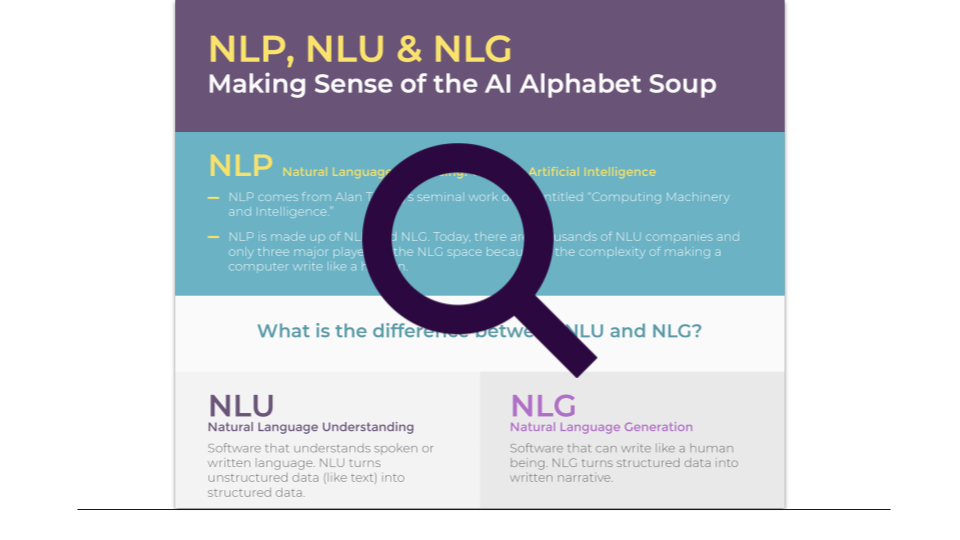Increase efficiencies and productivity by automating core reporting tasks for medical writing.
Automate core regulatory report documents across the CTD pyramid and dramatically accelerate submission timelines.
Increase efficiencies and productivity by automating core reporting tasks for medical writing.
Automate core regulatory report documents across the CTD pyramid and dramatically accelerate submission timelines.
Over the past few years, the term Natural Language Generation (“NLG”) has become more and more common. According to Gartner, “NLG offers significant opportunities to improve operations and user experiences” and its strategic assumption is that “by 2022, 25% of enterprises will use some form of natural language generation technology*”. But its rise in popularity also led to some confusion. NLU, NLP, and NLG are all different subsections of AI, which can be very confusing. So, what is NLG exactly?
Natural Language Generation is a subsection of Natural Language Processing (“NLP”). NLG software turns structured data into written narrative, writing like a human being but at the speed of thousands of pages per second. It makes data universally understandable and seeks to automate the writing of data-driven narratives like financial reports, product descriptions, meeting memos, and more.
Importantly, while NLG software can write, it can’t “read”. NLG turns structured data into human language but it is not able to, for example, read a news story and pull figures out of it. In fact, the science of taking unstructured data like a book and making it structured is called Natural Language Understanding.

|
Like any subsection of computer software, the functionalities of what software vendors call “NLG software” varies, with some even trying to commercialize simple templating systems which generate narrative like “mad libs” (yes, I know I am dating myself with that reference). Basically, these simple NLG systems have prewritten sentences with holes in them. For example, “The weather in <<location>> is <<temp>> degrees”. These simple systems turn one data point into a sentence which works for some very use cases but aren’t scalable, easily maintainable or generally enterprise ready.
Next-generation NLG is able to summarize larger amounts of data and explain WHY numbers are what they are. These systems allow companies to generate both back-office and front-office reports since they write more than just descriptive narrative. In fact, they go further with tools that are able to explain analysis, like Yseop Augmented Analyst, which writes in multiple languages and is built for large-scale, enterprise-level cloud or on-premise deployment, facilitating the generation of hundreds of reports upon request.
NLG software is used to streamline the production of written reports, and fits within a broad technology spectrum complementing RPA automation as well as BI data-driven decision making workflows. NLG is really the next mile in automation, thanks to its ability to model and scale human expertise at levels never reached before.
If you are curious to know how this can translate for your business, have a look at the different report types that Yseop offers as pre-packaged solutions with fast-track implementation abilities:
| Augmented Financial Analyst | Augmented Medical Writer |
| For whom? For Financial Institutions and Large CFO Departments | For what? For Pharma Compliance Reporting |
| – Fund Performance – Risk & Compliance – Performance – Company Financial Reports | – Clinical Study Reports – Patient Safety Narratives – Pharmacovigilance |
Now when someone asks “what is Natural Language Generation”, hopefully, you will have an answer. NLG is software that writes like a human being from structured data, generating narrative at the speed of thousands of pages per second.
* Gartner, Market Guide for Natural Language Generation Platforms, 27 June 2019, Bern Elliot, Anthony Mullen, Adrian Lee, Rita Sallam